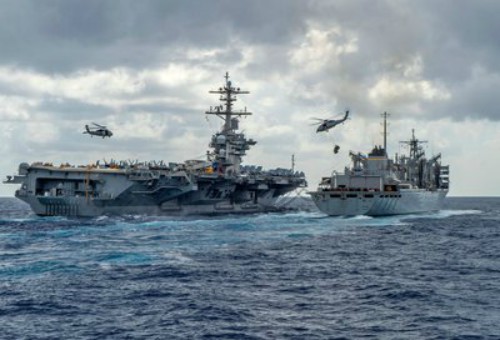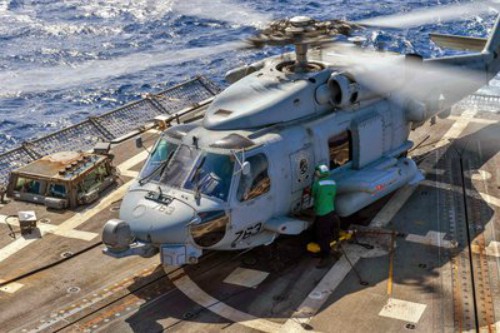To the accompaniment of a chorus of stern warnings of the US secretary of defense, secretary of state and national security adviser, the US deployed the USS Abraham Lincoln aircraft carrier to the Gulf to send a “clear and unmistakable message” to Iran.
Shortly afterwards, the Pentagon confirmed that it had sent the USS Arlington assault ship and a number of B-52 bombers to the Udeid Air Base in Qatar, signalling that they would reply to any Iranian attack with “unrelenting force”.

A B-52H Stratofortress from Barksdale Air Force Base, La., touches down at Al Udeid Air Base, Qatar, May 9, 2019 (Photo: Courtesy of CENTCOM Official Website)
Tehran had anticipated the American moves with similar escalatory language. It threatened to respond to Washington’s moves to hike up sanctions by blocking the Strait of Hormuz after the White House, last month, announced that it would end the exemptions from sanctions for several countries that were still buying Iranian oil. Iran subsequently warned that it would resume high-level uranium enrichment.
Despite the mounting temperatures, they remain well below meltdown. While the US notched up its military profile in the Gulf, the level of deployment is still not exceptional.
If Washington were actually to declare war on Iran, it would need to send in at least three times as much equipment into the eastern Mediterranean, Red Sea and Gulf of Oman.
Also, since Washington’s Gulf allies could be the first target of Iranian reprisals, the US would have to support their defence capacities.
This would require deploying more Patriot missile batteries in addition to replacing the four that were withdrawn from the Gulf late last year.
More batteries would have to be sent in to strengthen the missile defence shield that Tel Aviv and Washington have been working on in Israel during recent months.
The arrival of an American aircraft carrier in the Gulf is not such a surprise in and of itself given United States Central Command’s (CENTCOM) schedule of activities in the Middle East.
What is new, this time, is that the USS Abraham Lincoln, which was originally on route to the Black Sea in the framework of rising tensions between NATO and Russia, was ordered to change course, soon after which another warship was dispatched to the Gulf.

This handout picture released by the US Navy on May 8, 2019 shows the Nimitz-class aircraft carrier USS Abraham Lincoln (CVN 72) while conducting a replenishment-at-sea with the fast combat support ship USNS Arctic (T-AOE 9), while MH-60S Sea Hawk helicopters assigned to the "Nightdippers" of Helicopter Maritime Strike Squadron (HSM) 5, transfer stores between the ships (Photo: AFP)
If US and other Western reports on such deployments ranked them as a “warning message”, some fear that these messages could spiral into a more volatile situation.
A report in The Wall Street Journal (WSJ) last week cited US officials as saying that their government’s decision to reinforce its military presence in the region was informed by US intelligence indicating that Iran has made plans to target US forces in the Middle East.
The sources told the newspaper that the intelligence was solid and specific, to the degree that it was possible to pinpoint where the attacks could be carried out against the US presence in Syria and who would be carrying them out.
The New York Times similarly reported that US officials — unnamed — told the newspaper that the White House and Defense Department decided to shore up defenses against Iranian threats in light of intelligence showing that Iran was mobilising proxy groups in Iraq and Syria to attack US forces.
According to an article posted on 6 May on the Axios news site, the US received its information on the alleged Iranian plot to attack US interests in the region from Israel — Mossad specifically.
The article cited Israeli officials as saying that information about possible Iranian plots against the US or its allies in the Gulf were raised two weeks ago in talks held at the White House between an Israeli delegation headed by National Security Adviser Meir Ben Shabbat and a US team led by John Bolton.
US actions are informed by both political and military motives. The former are more immediately assessable while the latter will need to be tested in the framework of developments in the foreseeable future.
Warning Messages
This is the immediate aim of the recent deployments. Washington wanted to use a display of military muscle in the Gulf in order send Iran the message that it is prepared to deter any potential Iranian aggression and that this deterrent action will not be directed against Iran’s regional proxies in the event that they threatened US interests in the region or those of its regional allies, but against Iran directly.
Bolton put this into words when he explained that the purpose of having the USS Abraham Lincoln change course was “to send a clear and unmistakeable message to the Iranian regime that any attack on United States interests or on those of our allies will be met with unrelenting force.”

This picture shows an aviation electronics technician removing a power cord from an MH-60R Sea Hawk Helicopter assigned to the "Grandmasters" of Helicopter Maritime Strike Squadron (HSM) 46 during flight quarters aboard the Arleigh Burke-class guided-missile destroyer Nitze (DDG 94), underway as part of Abraham Lincoln Carrier Strike Group (ABECSG) (Photo: AFP)
Securing The US' Options
The US perceives Iran as an obstacle to arrangements it is perusing on other regional issues, as Mike Pompeo indicated during his current European tour.
For example, the US and Israel agree that a permanent Iranian presence in Syria and Iranian designs to reinforce this by developing a military infrastructure in Syria independent from the Syrian military pose a threat to Israel and to US forces in Syria, especially those stationed in Al-Tanf Base near the Syrian border with Iraq.
The US also wants to keep its options open in Iraq as evidenced by a plan to shift US forces from Syria to the Ain Al-Assad Base in Iraq in light of threats by Iraqi militia groups.
After Trump announced that US troops would remain stationed in Iraq in order to keep an eye on Iran, Asaib Ahl Al-Haq group warned that it would target US forces in Iraq.
Increasing The US Military Presence
This is clearly the most important motive in terms of its military and strategic implications. In this regard, one was struck by US Acting Defense Secretary Patrick Shanahan’s description of the deployment of the aircraft carrier group and some bombers to the Middle East as “prudent repositioning” of assets.
Shanahan’s choice of words hints at the possibility of a new and more permanent form of deployment reflecting Washington’s desire to increase its presence in the region to a level it deems commensurate with the likelihood of escalation on the part of Iran and its regional proxies.
The foregoing developments beg an important question: if President Trump is so confident about the efficacy of notching up economic sanctions against Iran to the degree that he has contacted Swiss officials to give them a phone number on which Tehran can reach him directly when it is ready to talk, why is the US brandishing possible recourse to military force?
One answer to the question was proposed by Seyed Hossein Mousavian in the National Interest magazine on 5 May beneath the heading, “Can We Stop the Slow Slide to a US-Iran War?” Mousavian, a Middle East security and nuclear policy specialist at Princeton University, believes that it is possible to contain the current confrontational trend.
The US and Iran have shown that they can work together. They cooperated in the fight against terrorism during the wars in Afghanistan and Iraq, for example, and Iraqi officials have frequently stressed to Washington that Iran was an indispensable asset in the war against Islamic State group terrorism.
He reminds us that President Trump has committed himself to a policy of averting costly foreign wars and that Trump has repeatedly said that the US had “stupidly” spent trillions of dollars on futile wars in Afghanistan and Iraq and elsewhere.
In addition, Iran and the US have long practised a strategy of “No war, no peace,” and Mousavian can see no logical reason why this principle should end.
He also believes that, despite the domestic difficulties, the Iranian people will rally behind the regime when it comes to resisting all economic, diplomatic or military policies that aim to bring Iran to its knees.
Mousavian concluded with an appeal to “international, US and regional policymakers [to] come together to chart a diplomatic course that promotes broad dialogue and engagement with Iran to avoid a possible war”.
The opposing view argues that the confrontational trend cannot be contained. The US had tried this option before without tangible results. Moreover, Iran has expanded regionally until it came to pose a serious threat to the US and its regional allies.
This camp also believes that “something” indicates that Iran has decided to escalate tactically against the interests of the US and its Middle East allies, necessitating preparations for recourse to the military option, as was indicated in a recent New York Times article that suggests that Tehran is attempting to “prod the United States into a miscalculation or overreaction” that it will ultimately backfire in favour of Iran.
In fact, the two opposing viewpoints overlap in certain ways. Both are informed by the lack of dialogue and mutual trust between Washington and Tehran, and by their differing outlooks on regional security arrangements.
These have become increasingly complex in view of the Iranian expansionism that has introduced dimensions to regional equations that extend beyond the Iranian nuclear and missile capacities.
An important dimension is Iran’s alliances with Russia and Syria, which raise the question of the Russian presence in the Middle East and the possibility that Moscow might want to counter the US’ display of military muscle with a display of its own, especially now that it has upped its naval profile in Tartus.
Another dimension has to do with Turkey. The US has long relied on Turkish logistic support in the wars it waged in this region and, above all, on access to the Incirlik Air Base.
This is no longer an option now that Ankara has determined to pursue an independent course and ignore longstanding joint interests with the US.
*A version of this article appears in print in the 16 May, 2019 edition of Al-Ahram Weekly under the headline: Hot summer for Washington and Tehran?
Short link: